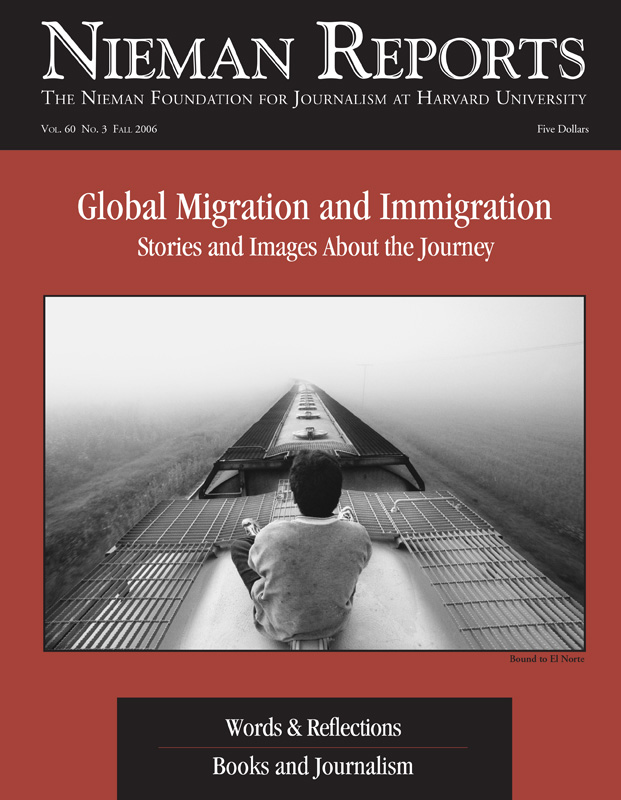Photos and captions by Hector Amezcua/The Sacramento Bee.
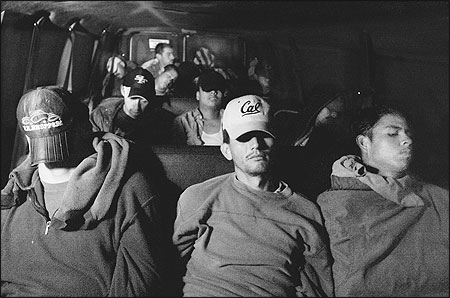
Just minutes after they rolled out of bed and off the motel floors at 3 a.m., Central Valley Forestry workers got a little extra sleep as they rode for two hours to the Tahoe National Forest from Oroville, California. None of the workers, including the driver, wore their seatbelts as required by state law. For some pineros the trip to the forest has been deadly because of the early hours riding on winding forest roads. June 2005.
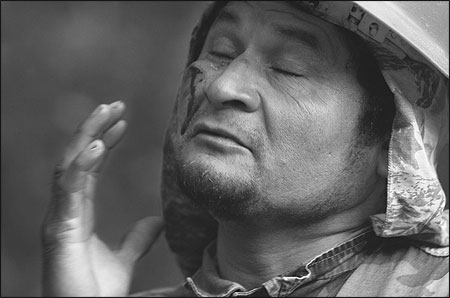
Eliseo Domínguez, a seven-year veteran on U.S. forest lands, begins to bleed from his cheek after suffering a cut that required five stitches. "I'm alright, I can continue working," said Domínguez after he injured himself and finished taking down the tree. Foreman Manuel Burac, unable to administer first aid, thought differently and dispatched Domínguez to the hospital. The lack of proper safety equipment continues to cause injuries to workers in America's forests. September 2005.
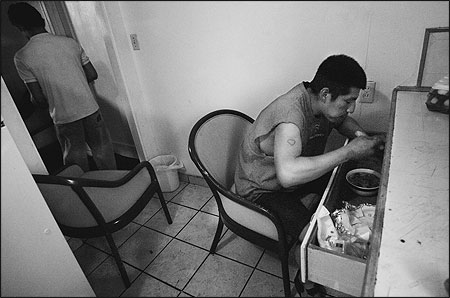
Far away from his wife and children in Mexico, Mauricio Ontiveros used a kitchen drawer to eat dinner in a motel room he stayed in with his forestry coworkers who shared the cooking and cost of food. June 2005.

Modesto Alvarez, 34, of Honduras, quenched his thirst at a snowmelt creek in the Tahoe National Forest after he finished planting seedlings. For Alvarez, and the many pineros working in America's forests, drinking from creeks is not uncommon, but the results can sometimes lead to dangerous cases of giardiasis, an intestinal infection that has cost some workers their jobs. June 2005.

Macario Martín Ordoñez, 70, covers his face as he visits the grave of his son Alberto Martín Calmo, in Todos Santos, Guatemala. Alberto Martín was one of five people killed in March 2004 while traveling in a van in Washington on their way to pick salal, a small shrub. Martín, who was raising three of his son's five children, had a crypt built next to his son's because he felt he was on his death bed. March 2005.
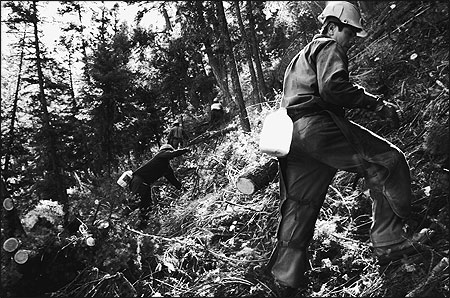
Paulino Olivo, right, of Veracruz, Mexico, borrowed $1,000 to obtain an H-2B visa with Global Forestry so he could work in Montana's Bitterroot National Forest. Olivo and other coworkers who then went to work for Universal Forestry were making burn piles. On his hip Olivo carried a mixture of water and oatmeal to help him stay strong on the steep terrain. September 2005.
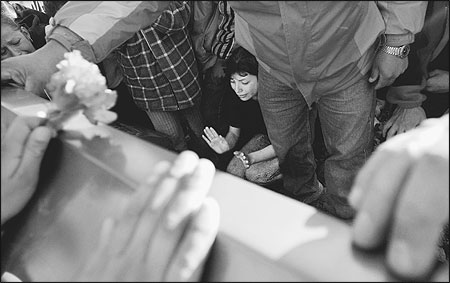
As the coffin of Juan Carlos Ríos is closed in the cemetery, his 13-year-old niece Martha Ríos holds her hands as if to keep it from closing. He was killed on an Oregon highway just a few miles from his first $10-an-hour job planting trees. "He lived with us. He would do little things with us, play baseball. I'll miss being with him," she said.

Just minutes after they rolled out of bed and off the motel floors at 3 a.m., Central Valley Forestry workers got a little extra sleep as they rode for two hours to the Tahoe National Forest from Oroville, California. None of the workers, including the driver, wore their seatbelts as required by state law. For some pineros the trip to the forest has been deadly because of the early hours riding on winding forest roads. June 2005.

Eliseo Domínguez, a seven-year veteran on U.S. forest lands, begins to bleed from his cheek after suffering a cut that required five stitches. "I'm alright, I can continue working," said Domínguez after he injured himself and finished taking down the tree. Foreman Manuel Burac, unable to administer first aid, thought differently and dispatched Domínguez to the hospital. The lack of proper safety equipment continues to cause injuries to workers in America's forests. September 2005.

Far away from his wife and children in Mexico, Mauricio Ontiveros used a kitchen drawer to eat dinner in a motel room he stayed in with his forestry coworkers who shared the cooking and cost of food. June 2005.

Modesto Alvarez, 34, of Honduras, quenched his thirst at a snowmelt creek in the Tahoe National Forest after he finished planting seedlings. For Alvarez, and the many pineros working in America's forests, drinking from creeks is not uncommon, but the results can sometimes lead to dangerous cases of giardiasis, an intestinal infection that has cost some workers their jobs. June 2005.

Macario Martín Ordoñez, 70, covers his face as he visits the grave of his son Alberto Martín Calmo, in Todos Santos, Guatemala. Alberto Martín was one of five people killed in March 2004 while traveling in a van in Washington on their way to pick salal, a small shrub. Martín, who was raising three of his son's five children, had a crypt built next to his son's because he felt he was on his death bed. March 2005.

Paulino Olivo, right, of Veracruz, Mexico, borrowed $1,000 to obtain an H-2B visa with Global Forestry so he could work in Montana's Bitterroot National Forest. Olivo and other coworkers who then went to work for Universal Forestry were making burn piles. On his hip Olivo carried a mixture of water and oatmeal to help him stay strong on the steep terrain. September 2005.

As the coffin of Juan Carlos Ríos is closed in the cemetery, his 13-year-old niece Martha Ríos holds her hands as if to keep it from closing. He was killed on an Oregon highway just a few miles from his first $10-an-hour job planting trees. "He lived with us. He would do little things with us, play baseball. I'll miss being with him," she said.
